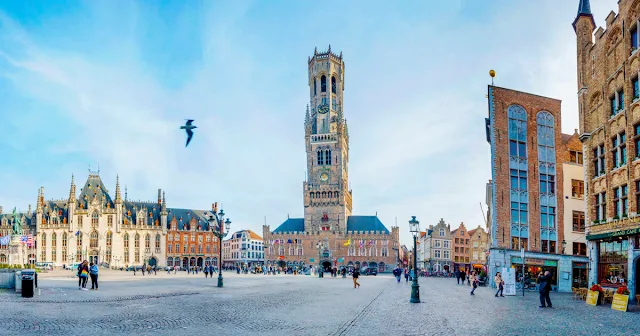Belgium
Exploring Belgium: A Comprehensive Overview
Belgium, a small yet culturally rich country located in Western Europe, is often overlooked by travelers in favor of its larger neighbors. However, Belgium is a land of remarkable diversity, boasting a unique blend of languages, cultures, and traditions. This article aims to provide an in-depth look at Belgium, covering its geographical and historical background, cultural practices, social dynamics, economic landscape, and most importantly, its tourist attractions.
 |
| Grand Place |
Geographical Overview
Belgium is bordered by France to the southwest, Luxembourg to the southeast, Germany to the east, and the Netherlands to the north. The country covers an area of approximately 30,528 square kilometers, making it one of the smallest countries in Europe. Despite its size, Belgium is divided into three distinct regions: Flanders, Wallonia, and the Brussels-Capital Region.
Flanders
Flanders, located in the northern part of the country, is primarily Dutch-speaking. It is known for its picturesque medieval towns, vibrant cities, and beautiful countryside. The region is characterized by flat landscapes, rivers, and canals, making it ideal for cycling and walking.
Wallonia
In contrast, Wallonia, situated in the south, is predominantly French-speaking. The landscape here is more hilly, with the Ardennes forest offering a striking contrast to the flatlands of Flanders. Wallonia is known for its charming villages and historical sites, reflecting the region’s rich cultural heritage.
Brussels
The Brussels-Capital Region is officially bilingual, with both French and Dutch being widely spoken. Brussels serves as the de facto capital of the European Union and is home to numerous international institutions. The city is renowned for its stunning architecture, including the iconic Atomium and the Grand Place, a UNESCO World Heritage Site.
Historical Context
Belgium's history is as complex as its geography, marked by a blend of various cultural influences. The region has been inhabited since prehistoric times, with significant archaeological sites dating back to the Paleolithic era.
Roman and Medieval Period
 |
| Building of the Roman Empire |
Belgium was part of the Roman Empire from the 1st century BC until the 5th century AD. The Romans established cities like Tervuren and Tongeren, which still bear traces of their Roman heritage. Following the fall of the Roman Empire, Belgium became a battleground for various European powers, including the Franks, Vikings, and later the Holy Roman Empire.
During the medieval period, Belgium flourished as a center of trade and commerce. Cities like Bruges, Ghent, and Antwerp became wealthy trading hubs, known for their textile industries. The flourishing economy contributed to a rich cultural scene, giving rise to notable artists such as Jan van Eyck and Pieter Bruegel the Elder.
The Rise of Modern Belgium
In the 16th century, the region was engulfed in religious conflicts between Catholics and Protestants. This tumultuous period ultimately led to the Eighty Years' War, which resulted in the separation of the northern provinces, forming the Dutch Republic, while the southern provinces remained under Spanish rule.
Belgium gained independence in 1830 after a revolution against Dutch rule, establishing itself as a constitutional monarchy. The country underwent rapid industrialization in the 19th century, becoming one of the first industrialized nations in Europe.
Cultural Practices and Social Dynamics
Belgium is renowned for its diverse cultural practices, influenced by its complex history and multicultural population. The country is home to three official languages: Dutch, French, and German. This linguistic diversity reflects the regional differences and the coexistence of various cultural traditions.
Festivals and Celebrations
Belgium hosts numerous festivals throughout the year, celebrating everything from music to gastronomy. One of the most famous events is the Carnival of Binche, recognized by UNESCO as a Masterpiece of the Oral and Intangible Heritage of Humanity. This colorful celebration features parades, traditional costumes, and the famous Gilles, who throw oranges into the crowd.
Another notable event is the Ommegang, a historical reenactment held in Brussels, showcasing the city’s rich history and traditions. The event attracts thousands of visitors each year, immersing them in the vibrant culture of Belgium.
Cuisine
Belgian cuisine is a reflection of its rich cultural heritage. The country is famous for its chocolate, waffles, and fries, often considered national symbols.
Chocolate: Belgium is renowned for producing high-quality chocolate, with brands like Godiva and Neuhaus leading the way. The country hosts several chocolate festivals, celebrating this delicious treat.

Waffles Waffles: Belgian waffles come in various styles, including the Brussels waffle, known for its light, airy texture, and the Liège waffle, which is denser and sweeter.
Fries: Belgian fries, often served with a variety of sauces, are a must-try. Many locals believe that the best fries are served with a dollop of mayonnaise.
In addition to these delicacies, Belgium is also famous for its beer culture, with hundreds of breweries producing a wide range of styles, from Trappist beers to lambics.
Economic Landscape
Belgium has a highly developed economy, known for its diverse industries, including manufacturing, services, and agriculture. The country is a significant player in international trade, with its strategic location making it an essential gateway to Europe.
Industry and Trade
The industrial sector in Belgium is diverse, ranging from textiles to machinery and chemicals. The country is also a major producer of steel and has a strong automotive industry, with companies like Volvo and Audi having production facilities in the region.
Trade is vital to Belgium's economy, with the Port of Antwerp being one of the largest ports in Europe. The port plays a crucial role in international shipping and logistics, contributing significantly to the country’s economic growth.
Tourism
Tourism is a vital sector in Belgium's economy, attracting millions of visitors each year. The country's rich history, vibrant culture, and beautiful landscapes make it a popular destination for travelers seeking both relaxation and adventure.
Tourist Attractions
 |
| Grand Place |
Belgium offers a wealth of attractions for visitors, ranging from historic cities to stunning natural landscapes. Here are some of the most important tourist destinations in Belgium:
Brussels
Grand Place: The central square of Brussels is a UNESCO World Heritage Site, surrounded by opulent guildhalls and the Town Hall. It hosts various events throughout the year, including flower carpet festivals and Christmas markets.

Atomium Atomium: This iconic structure was built for the 1958 Brussels World's Fair and has become a symbol of the city. Visitors can explore the spheres and enjoy panoramic views of Brussels from the top.
Bruges
Known as the “Venice of the North,” Bruges is famous for its medieval architecture, picturesque canals, and cobblestone streets. Key attractions include:
 |
| Belfry of Bruges |
Belfry of Bruges: Climbing the 366 steps of the Belfry rewards visitors with breathtaking views of the city.
Markt Square: The heart of Bruges, featuring colorful buildings and the bustling market.

Markt Square
Ghent
Ghent is a vibrant city known for its historical landmarks and lively atmosphere. Highlights include:
 |
| Gravensteen Castle |
Gravensteen Castle: A medieval castle that offers insight into the city’s history and stunning views from its towers.
St. Bavo's Cathedral: Home to the famous Ghent Altarpiece, a masterpiece of Northern Renaissance art.
Antwerp
Antwerp is a dynamic city known for its fashion, art, and diamond industry. Must-visit attractions include:
 |
Antwerp |
Antwerp Cathedral: A UNESCO World Heritage Site, renowned for its stunning architecture and works by the artist Rubens.
Museum aan de Stroom (MAS): A modern museum showcasing the city’s history, culture, and art, with a rooftop terrace offering spectacular views.
Leuven
 |
| Leuven Town Hall |
Home to one of the oldest universities in the world, Leuven is a vibrant student city. Key attractions include:
Leuven Town Hall: A stunning example of Gothic architecture, known for its intricate façade and detailed sculptures.
Old Market Square: Often referred to as the “longest bar in the world,” this lively square is lined with cafes and bars, making it a popular gathering place for locals and visitors alike.

Old Market Square
Conclusion
Belgium is a country rich in history, culture, and natural beauty. From its charming medieval towns to its vibrant cities, Belgium offers a unique blend of experiences for travelers. Whether you’re indulging in delicious chocolates, exploring historic sites, or enjoying the lively atmosphere of a local festival, Belgium is sure to leave a lasting impression.
As you plan your visit, consider immersing yourself in the local culture, trying traditional dishes, and exploring the hidden gems that make Belgium a truly remarkable destination.
References
- "Belgium." Lonely Planet. www.lonelyplanet.com/belgium
- "Brussels: The Heart of Europe." Visit Brussels. www.visit.brussels
- "A Taste of Belgium." Flanders Tourism. www.visitflanders.com
- "Cultural Events in Belgium." Wallonia Tourism. www.walloniabelgiumtourism.co.uk
- "Belgium’s Economy." The World Bank. www.worldbank.org
- "Belgium’s Tourist Attractions." Visit Belgium. www.visitbelgium.com
This article provides a detailed exploration of Belgium, highlighting its geographical, historical, cultural, and economic significance while showcasing its tourist attractions. The references and websites mentioned offer further insights and resources for those interested in delving deeper into the country's offerings.




No comments